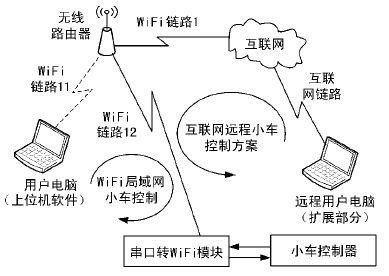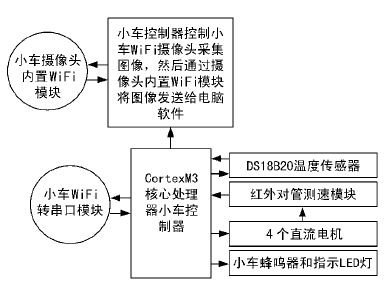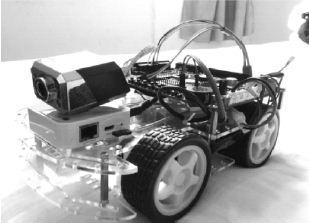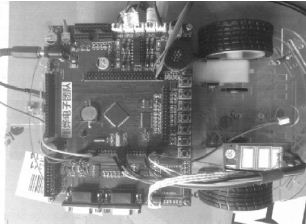WiFi IoT car designed with Cortex-M3 microcontroller
The WiFi IoT car design solution uses the computer PC software to control the movement of the car through wireless WiFi and collect the information of the car. Compared with the traditional "smart car", the main feature is the use of 32-bit high-performance microcontroller control, Internet communication mechanism and computer PC software control. This solution combines computer software, network communication, image processing, graphic display, motion control, speed acquisition and temperature acquisition, and has the relevant characteristics of "Internet of Things". Most of the traditional car control uses infrared communication, and the remote control is used for control, which is not only limited by distance, but also far from the intuitive and beautiful computer software. Internet communication enables the car to have remote control capabilities, which is beyond the reach of infrared communications. In addition, the car control chip of this solution adopts Cortex-M3 single-chip microcomputer, which has a very rich peripherals, which lays a foundation for the function upgrade and expansion of the car in the future.
1 overall design
The purpose of the WiFi IoT car design solution is to use computer software (referred to as the upper computer) to communicate with the car control terminal (referred to as the lower computer) through the Internet, thereby controlling the movement of the car, collecting the speed, temperature and video monitoring functions of the car. . The overall design is shown in Figure 1. There are 2 communication modes available in the figure. Among them, “WiFi LAN car control†adopts the way of LAN, and the upper computer, wireless router and car form a local area network to realize the purpose of controlling the car by the upper computer. The "Internet remote car control program" is a remote Internet method, which combines the upper computer and the small car to form an Internet, thereby realizing the purpose of remotely controlling the car. The technology of the two schemes is similar. Due to the limitations of experimental conditions, this design uses the local area network car control as an example to explain.

Figure 1 overall design
From the communication point of view, the wireless router is the data center of the upper computer and the lower computer. The upper computer creates a network interface to connect with the router through Winsocket socket programming, and the car end passes the WiFi module through a serial port to pass the serial port data through the WiFi. The module converts to a WiFi signal and interacts with the router. During this process, both the upper computer and the lower computer WiFi module have a separate LAN IP address. Network communication can be realized by the IP address of the upper computer and the lower computer.
From the perspective of control, the upper computer is the control center of the trolley. The upper computer sends a command to the trolley through the “buttonâ€. After receiving the command, the trolley returns the relevant data to the upper computer. The upper computer receives the data returned by the trolley. Parse and display it.
1.1 PC software design
The main function of the upper computer is to control the movement of the car, display the speed of the car, the surrounding temperature and the camera captured by the car. As shown in Figure 2, these functions are completed by two threads: "image, sound processing thread" and "car motion control, speed, temperature acquisition thread". The previous thread is mainly responsible for receiving and processing the image information and audio information transmitted by the WiFi camera of the car. This part mainly involves the related technology of DirectShow. The latter thread is mainly responsible for the control of the car movement, including "forward, backward, left turn, right turn, stop, acceleration, deceleration, turn signals and horns" as well as receiving temperature and speed information for handling the car's return, and displaying it with a virtual chart. come out. The 2 threads of the host computer software have created an irrelevant socket. The former is used for data interaction with the car WiFi camera, and the latter is used for data interaction with the car serial port to the WiFi module.

Figure 2 PC software design
1.2 lower computer software design
The lower computer software design, that is, the programming of the Cortex-M3 core processor, is shown in Figure 3. The design scheme mainly includes: camera control, control of 4 motors of the car, collection of temperature data of DS18B20, data collection of infrared tube speed module, processing and packaging of data after data acquisition. The camera control, motor control, and temperature and speed acquisition are all obtained in the form of functions. When the lower computer receives the relevant command from the host computer, it calls the corresponding function to obtain the result and then sends it to the host computer in a fixed format.

Figure 3 lower computer software solution
The core of the communication between the lower computer and the wireless router is the serial to WiFi module. Through this module, the serial data sent by the lower computer can be directly converted into a WiFi signal and transmitted. It can be configured in a variety of ways before using this module, and as long as it is configured, it can communicate with the established WiFi access point.
2 Design scheme features and extension instructions
2.1 Features
This program is designed based on the concept of combining computer software, Internet communication and single-chip technology. From the selection of the single-chip microcomputer, the determination of the communication scheme and the design of the host computer software, etc., there is a great special difference with the traditional "smart car". The following are the three major features of this design:
1 The control chip of the car adopts the powerful Cortex-M332 high-performance, low-power processor. The chip has a wealth of peripherals. The chip also supports the RLTx real-time operating system provided by ARM, which is very convenient to use.
2 Communication method adopts TCP / IP communication protocol, and uses wireless WiFi technology to realize control of the car. This communication scheme (as shown in Figure 1) can connect to a remote network with a private IP address, and can remotely control the car through a remote network, which will have good value in the fields of "smart home" and "remote medical care";
3 Using computer host computer management software, MCU control, network communication and computer software are effectively combined. This scheme is designed with the PC software to manage the car, which is in line with the design concept of simplifying and integrating complex control.
2.2 Extended Description
The powerful and rich peripheral resources of the Cortex-M3 microcontroller provide a strong foundation for the expansion of the design. In addition to the functions that have been implemented, the MCU has two serial ports left unused, which allows the car to add the following functions: GPS navigation, voice and GSM/GPRS texting, calling and wireless Internet access.
3 Program difficulties and key technologies
The difficulties of the program are:
1 The movement of the upper computer controls the car to have high requirements for real-time performance, and the speed of collecting the car is displayed by the dial, which puts forward the requirements for the stability of communication, and for the TCP/IP communication with inherent delay It is even more difficult;
2 Image processing is mainly based on the technology provided in the online DirectShow development guide. Many internal processing mechanisms and signal filters are difficult to use;
3 The speed dial of the upper computer shows that the speed is inconsistent, and occasionally there is a phenomenon of “carryingâ€.
The key technologies are: 1 the development of communication protocol; 2 the method of collecting and processing information by the lower computer; 3 the programming of the upper computer socket, the dynamic display speed of the speed dial; 4 the display of the car monitor video; 5 the car as the WiFi access point Into the network.
4 System simulation results analysis
4.1 WiFi Internet of Things trolley overall appearance
The overall appearance of the car is shown in Figure 4 and Figure 5. The system consists of a host computer and a trolley, and the trolley control circuit is placed on the trolley. The car controller mainly includes: motor control, speed measurement, temperature measurement, communication, image acquisition and wireless routing.

Figure 4 WiFi Internet of Things trolley

Figure 5 car top view
4.2 System overall debugging
WiFi IOT trolley control system PC interface mainly includes: network settings, function settings, video monitor area, motion control area, speed display area, temperature display area and debugging window. The network setting is used for network connection between the host computer and the trolley. Enter the IP address of the trolley and click “Connectâ€. The video surveillance function requires the WiFi camera to be installed on the car. Click the “Call†button below the video display box to connect to the IP address of the WiFi camera. If the connection is successful, the image captured by the camera can be obtained. The motion control area is used to control the movement of the trolley and display the turn signals, horns, etc. of the trolley. The speed display area is a speed dial for displaying the real-time speed of the car. The temperature display area is a graphical interface of the thermometer that displays the temperature of the DS18B20 sensor on the cart. The communication debug window is used when debugging the program.
4.2.1 Network connection
Network connection debugging uses the TCP network debugging assistant downloaded from the Internet. First, set the TCP debugging assistant to the server mode, set the server monitoring IP to 192.168.16.110, and set the port to 345 to connect to the network. This IP address and port number are UART to WiFi module. The IP address and port number are set by the MCU with the AT command. After the network connection is successful, the car will continue to send "014, SR1, TE1, 029.6", indicating that the current temperature of the car end is 29.6 °C.
4.2.2 Car movement
The debugging of the motion control part of the trolley is also debugged by the host computer and the TCP network debugging assistant. After connecting the network, click “↑â€, “↓â€, “â†â€, “→â€, “█â€, “Acceleration†and “Deceleration†on the host computer. ":014, SG1, UP1,;", ":014, SG1, DO1,;", ":014, SG1, LE1,;", ": 014, SG1, RI1," are sequentially received on the debug assistant receiving window. ;", ": 014, SG1, ST1,;", ": 014, SG1, AD1,;" and ": 014, SG1, SU1,;", respectively, indicating "forward", "backward", "left turn" , "Right turn", "Stop", "Acceleration" and "Deceleration".
4.2.3 Display of temperature and speed
The temperature and speed tests are tested directly during the actual movement of the car. Open the trolley, connect the host computer, hold the DS18B20 on the trolley with your hand, observe the change of the temperature of the analog thermometer on the temperature display area of ​​the upper computer, and then turn the wheel of the trolley to observe the change of the speed dial pointer of the upper computer speed display area, change the temperature and The speed is found to change the speed dial pointer and the temperature indication accordingly, so it can be judged that there is no problem with the transmission of temperature and speed.
5 Conclusion
The expected functionality can be achieved by repeatedly debugging and modifying the code. The communication is stable, the control of the trolley is reliable, and the accuracy and sensitivity of data acquisition meet the requirements. The stability and reliability of the system far exceeds that of ordinary infrared remote control cars and wireless radio frequency remote control cars without involving remote network control. The significance of the scheme lies in the effective combination of computer software technology, network technology and single-chip technology, which highlights and deepens the meaning of “Internet of Thingsâ€, and will be widely used in social life and production in the future. The application areas of the program mainly include driverless, remote monitoring and smart home.
Dedicated audio cable,Horn line power amplifier line,Speaker audio cable,Audio dedicated cable
Jiangsu D-Bees Smart Home Co., Ltd. , https://www.cI-hometheater.com